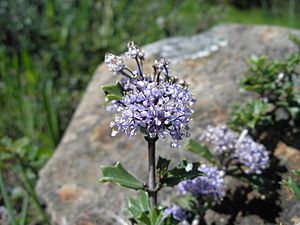Rincon Ridge ceanothus facts for kids
Quick facts for kids Rincon Ridge ceanothus |
|
|---|---|
 |
|
| Scientific classification | |
| Genus: |
Ceanothus
|
| Species: |
confusus
|
The Ceanothus confusus, also known as the Rincon Ridge ceanothus, is a special type of shrub. It belongs to the Rhamnaceae family, which includes many different kinds of plants. This plant is only found in a specific part of northern California. It grows in the coastal mountains located north of the San Francisco Bay Area.
What is the Rincon Ridge Ceanothus?
The Rincon Ridge ceanothus is a low-growing plant that spreads out. It often forms a short, dense mat on the ground. This mat can grow to be about 1.2 meters (about 4 feet) wide. It's a unique plant because it's endemic to this small area of California, meaning it doesn't naturally grow anywhere else in the world.
Where Does It Live?
This special shrub likes to live in certain types of environments. You can find it in:
- Coniferous forests: These are forests filled with cone-bearing trees like pines and firs.
- Woodlands: Areas with many trees, but often more open than a dense forest.
- Chaparral: A type of shrubland common in California, known for its dense, tough shrubs.
What Does It Look Like?
The Rincon Ridge ceanothus has some interesting features:
- Stems and Twigs: The main stems are usually gray-brown. However, the new twigs that grow are often reddish and have a soft, fuzzy feel.
- Leaves: Its leaves stay green all year round, which means they are evergreen. They grow in pairs directly opposite each other on the stem. Each leaf is small, about 2 centimeters (less than an inch) long. They are oval-shaped and have 3 to 5 noticeable teeth along their edges. The top side of the leaf is shiny green, while the underside is lighter in color and feels like felt. You can also see small hairs along the veins on the underside.
- Flowers: The plant produces small clusters of beautiful blue or purple flowers. These clusters are called an inflorescence.
- Fruit: After the flowers, the plant grows a small fruit. This fruit is a horned capsule, which means it has small horn-like bumps on it. It's about half a centimeter (about 0.2 inches) wide.

